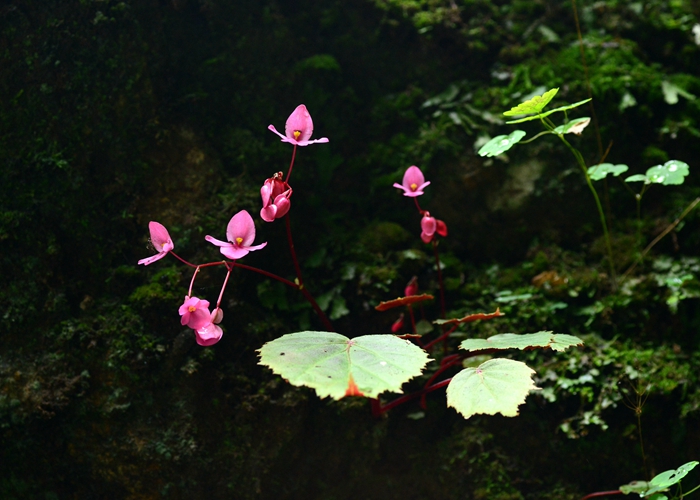- Scientific Name: Begonia qingchengshanensis H.Z.Li, C.I Peng & C.W.Lin
- Ref: Phytotaxa 349(2):198. 2018
- Chinese Common Name: 青城山秋海棠 Qīngchéng Shān qiū∙hǎitáng
- Family: Begoniaceae
- Genus: Begonia
- Distribution: endemic to Qingchengshan, Sichuan.
- Photo: Mt. Qingcheng, Sichuan
Monoecious tuberous herb. Stem tuberous at base, tubers globose or sub-globose with numerous fibrous roots, producing erect or ascending stems ca. 2 cm long, 2.5–5 mm across, crimson, glabrous, internodes 0.5–1 cm long. Stipules pale green, triangular, 3–7 mm long, 2–5 mm wide, herbaceous, keeled, glabrous, margin entire, apex mucronate apiculate. Leaves alternate, held more or less horizontally; petiole terete, scarlet red to crimson (rarely green), 11−19 cm long, 2−4.5 mm across on basal leaves, ca. 2 cm long on uppermost leaves, glabrous or very sparsely tomentose; leaf blades symmetric or subsymmetric, slightly oblique, ovate to widely ovate, those at basal node of stem 6.5−13.5 cm long, 6.2–10 cm wide, broad side 3.3–5.2 cm wide, basal lobes cordate, 0.6–1.6 cm long, apex attenuate, margin biserrate and ciliate; leaf blades at stem terminal much smaller, ca. 2.5 cm long, 1.8 cm wide; leaf chartaceous, succulent,adaxially emerald green to olive green, sometimes tinged maroonish between tertiary veins, glabrous; abaxially palegreen to dark magenta, sometimes pale green along veins; venation palmate-pinnate, midrib distinguishable, 6–11.5 cm long, ca. 3 major lateral veins on either side of midrib, other primary veins branching dichotomously, tertiary veins reticulate. Inflorescences terminal, bisexual, cymosely branching panicle 6–10 cm long, peduncle 1.2–4.7 cm long, branched 2 or 3 times, erect, crimson, glabrous or very sparsely tomentose; protandrous. Bracts pale yellowish green to reddish, hyaline, persistent, those at basal node of inflorescence ovate to widely elliptic, 4.5–5.5 mm long, 3–4.5 mm wide, apex mucronate apiculate, glabrous, margin entire or subentire; uppermost bracts ovate to elliptic, 1.5–3.5 mm long, 1–2 mm wide, apex mucronate apiculate, margin denticulate. Staminate flower: pedicel 0.9–2.5 cm long,glabrous or very sparsely tomentose, tepals 4, pink to rose red, outer 2 widely ovate, 0.8−1.2 cm long, 0.8−1.3 cm wide, glabrous; inner 2 narrowly obovate, 0.7–1.2 cm long, 0.3–0.5 cm wide, apex obtuse or rounded; androecium zygomorphic, ca. 0.3 cm across; stamens yellow, 7–10(–15); filaments shortly fused at base; anthers obovate, ca. 1.5 mm long, 2-locular, apex retuse, subequal to filaments. Pistillate flower: pedicel 0.5–2 cm long, glabrous or very sparsely tomentose; ovary crimson, trigonous-ellipsoid, ca. 5 mm long, 3.5 mm thick (wings excluded), glabrous; 3-winged, wings unequal, shallowly trapezoid, ca. 5 mm long, lateral wings narrower, ca. 0.3–1 mm wide, abaxial wing to 3 mm wide, margin entire; ovary 3-locular, placenta unilamellate; tepals 3 or 4, pink to rose red, glabrous; outer 2 widely ovate, ca. 10 mm across, inner 1 tepals obovate, ca. 8 mm long, 3 mm wide, apex obtuse; styles 3, short fused at base, yellow, ca. 3 mm long, stigma spirally twisted. Capsule not seen. (Phytotaxa 349:198)
